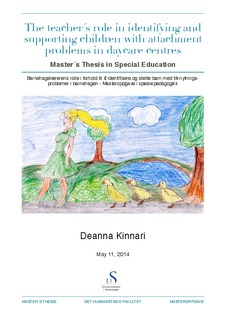| dc.contributor.author | Kinnari, Deanna | |
| dc.date.accessioned | 2014-07-01T07:35:45Z | |
| dc.date.available | 2014-07-01T07:35:45Z | |
| dc.date.issued | 2014-05-11 | |
| dc.identifier.uri | http://hdl.handle.net/11250/197031 | |
| dc.description | Master's thesis in Special education | nb_NO |
| dc.description.abstract | The primary goal of this investigation has two parts: to determine and highlight methods of identification of attachment problems and to suggest compensating practices for teachers with the aim of establishing a secure attachment in the classroom. A secondary goal is to identify how current practice accords with relevant theory. A final aim is to facilitate an awareness of attachment that initiates reflection and discussion in the educational community.
Bowlby´s attachment theory and Bronfenbrenner´s systemic theory provide the foundation for this study. Attachment theory sheds light on the significance of a child´s bond with her caregiver and how the security of the attachment affects development. Systemic theory accounts for contexts of development: teachers, classrooms, and communities which influence attachment and affect behaviour of young children both in the home and daycare context. Consequences for children with attachment disorders are often severe and therefore Perry´s “six core strengths” provide a useful framework for healthy child development. The preschool teacher can compensate by providing safety, structure, nurture, routines, and emotional support to a child with an insecure attachment. The window of opportunity is open for a limited time for young children which is why early identification and intervention is critical.
This study uses a qualitative approach with semi-structured interviews with five preschool teachers. The questions address characteristics of attachment and identification, the consequences of attachment problems, and prevention and intervention measures. The interviewees also responded to three case studies which included examples of secure, insecure, and disorganised attachments.
The results of the interviews indicate preschool teachers rely on child-observation as their main method for identification of children with attachment problems; they also indicate a need for teacher knowledge about child-parent observation and developmental charting as tools which aid in identification. This enables early intervention and the provision of compensatory measures for children with attachment problems in daycare centres. Group sizes influence teacher sensitivity and the quality of childcare, which is why politicians must be vigilant about attaining their goals for high adult-child ratios. The results also indicate the need for more professional knowledge concerning attachment, enabling teachers to create environments that nourish healthy development. Therefore the national reforms in early childhood education programs must both emphasise attachment and provide relational teacher training. | nb_NO |
| dc.language.iso | eng | nb_NO |
| dc.publisher | University of Stavanger, Norway | nb_NO |
| dc.relation.ispartofseries | Masteroppgave/UIS-HF-IGIS/2014; | |
| dc.subject | spesialpedagogikk | nb_NO |
| dc.subject | attachment | nb_NO |
| dc.subject | attachment problems | nb_NO |
| dc.subject | system theory | nb_NO |
| dc.subject | mentalization | nb_NO |
| dc.subject | observation | nb_NO |
| dc.subject | developmental charting | nb_NO |
| dc.subject | early identification | nb_NO |
| dc.subject | early intervention | nb_NO |
| dc.subject | adult-child ratio | nb_NO |
| dc.subject | compensation | nb_NO |
| dc.subject | VDP::Samfunnsvitenskap: 200::Pedagogiske fag: 280::Spesialpedagogikk: 282 | nb_NO |
| dc.title | The teacher´s role in identifying and supporting children with attachment problems in daycare centres | nb_NO |
| dc.title.alternative | Barnehagelærerens rolle i forhold til å identifisere og støtte barn med tilknytningsproblemer i barnehagen | nb_NO |
| dc.type | Master thesis | nb_NO |
